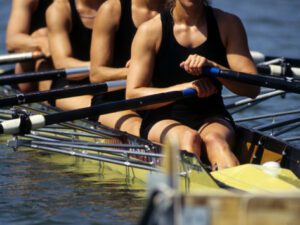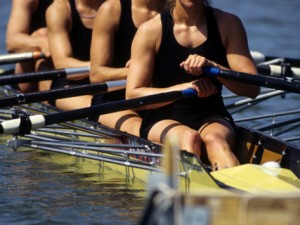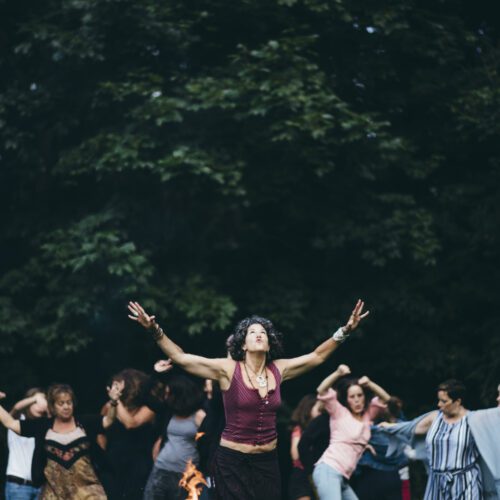 Okay, so to be clear…that’s not a picture of me in the boat. But after learning how to row this past month, and having found myself as part of an awesome boat of four women rowers, that picture represents who I see myself becoming.
Okay, so to be clear…that’s not a picture of me in the boat. But after learning how to row this past month, and having found myself as part of an awesome boat of four women rowers, that picture represents who I see myself becoming.
I have wanted to learn to row ever since I turned down an offer to join the Rutgers crew team my freshman year in college (5:30 am practice? No, thank you.) Living in Maine, I thought it might be easy to pick up, but there is gear, the time on the water and that “you gotta know someone” vibe that made it rather elusive and hard to land.
But I’m so glad it finally found me.
Thanks to a tip this summer from a client (turns out I did know someone…), I found my way into a boat of four women this August. We’ve done well as a team, it seems, and we’ve been given the nod by our coaches to continue rowing into September. They’ve all suggested we stick together. Apparently there is “magic” in our boat, so we’re going with it.
I keep thinking about my time with these women – essentially three strangers, and this boat, and being out on the water. That’s the thing rowing has given me this summer…time to think and reflect. It reminds me of when I was nursing my babies on the couch, that sensation of not needing to be anywhere but where you are and just having one clear task to do. So imagine my surprise when I have this same sensation, but with three other people “on the couch” with me. We are in a boat no wider than our hips. Riding low on the water. It’s all been quite remarkable and – as is my tendency – I can’t help but see it as a metaphor for how I am living my life. It’s rich.
This experience, as it turns out, is teaching me more than just how to row a boat. It’s gently teaching me about how to live my life.
What follows are some of my lessons from the boat, and how they are relevant to my life.
The hardest part is getting the boat in the water
Don’t let anyone tell you otherwise – that boat is unbelievably heavy. I’ve always thought I was pretty strong, but was seriously humbled by having to heft up and haul that bad boy above our heads. And at 38 feet long, it’s no easy task. There is rigging for each of the four oars that jut out, places you can and can’t grab, and this biting sensation when you let the boat rest on your shoulder as you walk. The whole procedure of getting the boat out of the racks and down to the water is riddled with awkward moments and ungainly motion. But what I’ve come to appreciate about this is: isn’t that always the case when we’re positioning ourselves for something we want? I think of giving a birth to a baby, starting my business, parenting…yup. Lots of awkward “unracking” to get me down to the good stuff. But when that boat finally comes off the shoulders and slips into the water, it’s all suddenly worth it.
It’s best not to look around
When you’re rowing with a group of four women, the boat can get kind of tippy. When you take your eyes off the gunnels (sides of the boat) or the person in front of you, things get dicey – you lose your focus, your weight shifts enough to make a difference, and you tend to overcompensate as a result to “fix” the problem. So I’ve learned it’s best not to look around. Then everything seems to fall into place. It reminds me of some advice heard recently that recommended “keeping your eyes on your own paper.” It was in reference to how distracting and ineffective market research can be in helping us with our own work. The idea is to stop spending time looking over there, at them, comparing and contrasting (and keeping up) with what others are doing, but instead limit the scope of your gaze to your own ideas, your own creation and your own work in the world. To focus on what is within your control and worry less about what everyone else is doing. I laugh just thinking about the idea of me trying to focus on the other women in my boat and how they are each rowing. The idea is absurd. In fact, one of our coaches said she has actually blindfolded her rowers in practice just so they can learn to feel their own way, focus on their own stroke and feel how it matches the rhythm of the boat as a whole. We should all be so wise.
Power flows beautifully into grace
I think I finally got this one. It’s something I’ve been after for a while – the ability to honor both power and grace without watering down or diminishing either. The boat taught me how. When you are at the front of your seat, in the “catch” where you are poised to pull your oar through the water, THAT is the moment for power to flow through you mightily. But then after the stroke, when your legs are extended and you’ve pulled the oar as far as you can, it’s time for the “release”, where you slowly bend your legs, back and then arms to return yourself to the front position again. The key is SLOW with the release. Not my strength, I’ll admit. I’m a power lover, so I took heed when the coach kept yelling, “EVEN SLOWER, LAEL!” Right. Slow for grace. Fast for power. She even taught us to count out the rhythm…the pull (power) is on 1, while the release occurs on 2, 3, and 4. I see now how they both get their time in the sun. One fuels the other – grace fuels power, power fuels grace. Push hard when it’s time for power. Move slowly when it’s time for grace. Got it. I’m all over it.
Work with motion, not against it
This was a tricky one, and I’m still not entirely clear I get it, but it feels important…like it’s a metaphor for a way to live with a bit more ease and efficiency. After one particular hard stroke, the coach asked us to freeze in position, right after we had pulled the oars. Over the screams of my abs as I held myself in that laid back position, I heard the coach yell, “which way is the boat moving?” We all pointed backward. Then she asked, “Which way is your body going to move next?” We all pointed forward. So conceivably, we were going to be working against the motion we just worked so hard to create. If we didn’t take our time with our “release” – to let go and return ourselves to the front of our seats with as much grace as possible (“like a dancer”, she said), we could undo all that effort of that last stroke. She had us look at how far and how fast we could propel our boat with just one stroke. Then, she asked us to essentially tip toe like mice to the front again, so as not to disturb any of that motion. And it worked. Just as the boat started to slow down in its glide, we were back in the “catch” and ready to give it another pull. It got me thinking of how often I might be undoing my own efforts, because I’m stuck in tiger-mode, instead of moving like a mouse.
Never underestimate the power of strangers to work together
As far as athletics are concerned, I’ve never really considered myself a team player. I like my own lane, my own equipment, my own success or failure with which to reckon. But rowing has shown me a side of myself I didn’t even know existed. Something has happened in that boat, and I apparently have been a part of it. The coaches keep commenting about how we’re a natural team and how we all seem to be plugged into each other. And there is not a lane in sight. I literally only have one oar in my possession. Last night we had the moment we’ve all been waiting for. We were ALL allowed to row at once – all four. Up until that point, we’d been rowing in teams of two, essentially creating two boats – one that rows and one that stabilizes. But last night we were given the green light and were instructed to match our strokes to the woman in the stern seat, who is at the front of our row of four (which is actually the back of the boat, and messes with my dyslexic brain to no end). We were all over the place, lurching and splashing. Apparently that’s to be expected. But then the stern woman started counting to herself to set the pace: ONE, two, three, four…ONE, two, three, four…” and one by one we all joined in. And that did it. One by one, we all connected ourselves to each other. No splashing, no lurching. Just one. Clearly we are miles from Beijing, but I’ll tell you this much: I will never again underestimate the power of strangers to move as one. Especially women.




